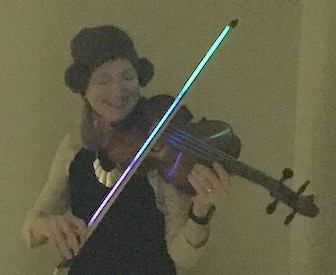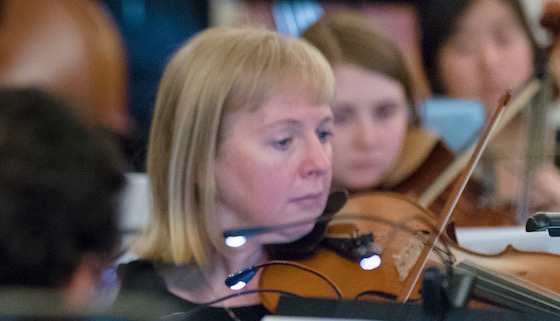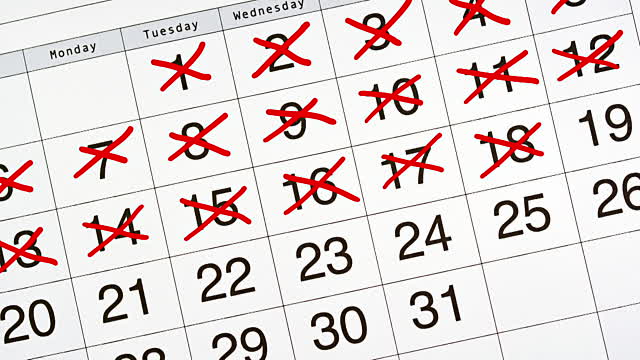Facebook has taken a lot of flack recently, for good reason, but one thing it is good at is bringing back the ghosts of Christmas past: “We hope you enjoy looking back and sharing your memories on Facebook, from the most recent to those long ago.” Each morning brings a bittersweet memory of something missing: the pageants, the choruses, the holiday concerts.

Last year, I am reminded, I played the Star Wars finale of the Nova Vista Symphony’s John Williams tribute with a glowing light-saber bow. But this year, in the Christmas present, as we approach the one-year anniversary of the time when everything changed, there’s a shadow over the proceedings, even on Facebook. Those revelers in the Leia hats, Yoda ears, and Jedi robes have no inkling what is coming.

I have been busy this year with teaching and with teaching online. While I find zooming as exhausting as the next person, I am happy to be rid of the daily car commute and to be able to eat lunch with family. The orderliness of online classrooms and learning management systems has its charms. Most of my high-school-age students say, about online learning, some variation of “it’s not what we expected or wanted, but we can handle it.” A few even prefer the ability to set their own schedules and work at their own pace. The reasons I want to get back to in-person school have to do with forming relationships, and with the hands-on, experiential activities that make learning stick, like Biology labs. And music.
Music has been hit harder than other activities, especially the kind of music I like best, which involves playing with others. I have learned two unaccompanied Bach preludes from memory so far during the pandemic, but solo playing isn’t my true love (or my strength, technically) and never has been. I’ve been fortunate to be able to participate in some amazing virtual ensembles, from the International L O V E Project–which had a professional conductor, sound editor, and roster of 1000 musicians from around the world, amateurs and pros both—to TACO’s Christmas Sing-along, which I’m going to describe in more detail below.

TACO stands for the “Terrible Adult Chamber Orchestra,” although only two of those words are really accurate (I’ll leave it up to the reader to decide which ones). The name was inspired by the Really Terrible Orchestra who play for fun and humor in Edinburgh, Scotland. TACO is conceived as a drop-in reading group that meets once a month. Its purpose is similar to the RTO in that its main point is enjoying playing together. But it doesn’t have a goal of practicing to get better. Instead its target is a broad range of people who don’t have time to rehearse weekly but who still want to play: adult starters, re-starters, older musicians with physical limitations, professionals and parents who are too busy with work or family to practice regularly. The group would have been celebrating its 10th anniversary this year, and its mailing list has grown to over 700, with 65-70 musicians coming to its monthly drop-in sessions pre-pandemic.

TACO’s founder and conductor, Cathy Humphers Smith, runs the group through the Los Altos Recreation Department, which sponsors them financially as a non-profit and guarantees them regular, reliable meeting space and publicity. I talked to Cathy–over zoom of course–about how the Christmas Sing-along project came to be.
Karen: Where did the idea come from to do this project?
Cathy: When the pandemic first hit, we wanted to do a group video project like those you’ve been seeing for other local orchestras, and I decided on Viva la Vida by Coldplay. That song is straightforward and doesn’t have any major tempo or key changes so I thought it was something we could do as a group with all volunteers. We have a sister organization in LA, called TACO Los Angeles, and we collaborated with them. We got a great response to our call, about 25 musicians from Silicon Valley and 10 from LA, and then one of our LA folks in the animation industry was able to do our editing for us. It was successful and people loved doing it.
So, after the success of Viva la Vida, the pandemic was still going on, and people were asking, when are we going to do another group project?
Karen: High school students got involved this time, and it’s being shown on public access TV. How did that all come about?
Cathy: I got a phone call from the Los Altos Recreation Department Senior Services. Normally they provide all kinds of activities and classes for seniors at the senior center, but they were worried about isolation during the holidays because of the pandemic.
So they produced programming on cable TV for seniors isolated in the community, from 10am-noon every day through December. They are showing Viva La Vida on this channel, and they asked us to put together a Christmas concert. They also asked the Peninsula Symphony to contribute some of their chamber music. After that, I started thinking about this audience. What pieces could I choose and how to introduce them?
Karen: So you chose the music?
Cathy: Yes. I had it all ready. It was simple, well-known carols. But then I realized, Oh no! It’s 10 videos! Each video on its own is short and simple like Viva la Vida, but now there are 10 of them. I didn’t know how to get them all put together.
Karen: Could you ask the same person who did Viva la Vida?
Cathy: I asked him, but he didn’t have time. The Freestyle Academy at Mountain View High School is local, and the students are in it because they are interested in video and animation, so I sent an email out to [their teacher] Leo Florendo. He offered it as extra credit, and there were several students interested. But they had to do it on top of their regular school work, and in some cases their college applications, and only 4 ended up being able to participate. They are all musicians themselves and 2 of them are seniors in film. I had a zoom meeting with all of them to meet them and explain how we were going to keep track of the videos. They received an honorarium, and it was a huge amount of work!
Karen: What about recruiting musicians?
Cathy: I initially had 60 TACO musicians interested too, but in the end there were only 30 who could submit videos and I had to get some ringers. I had some older musicians as well and they couldn’t have participated unless I helped them with the recording. For example, I recorded one video on my back deck. Behind the musician’s green sweater you can see it getting dark in my backyard in the later takes. I pulled an all-nighter to figure out the best takes for some of these recordings.
Karen: I’ve done these kinds of videos before so I knew how to record myself with my phone, but there were some new wrinkles with these recordings for TACO, like saying “pop” before starting.
Cathy: I had to get the conducting videos out already in mid-October and then there was a deadline with the high school of early November to get all the data loaded into google folders by song.
Once we had all the videos, the students started going through the data and creating a rough draft of the mixing. Keeping track of all of the data was complicated, and so was aligning the videos. You can’t just line it up at the “pop” at the beginning and be done, you have to line it up at other points as well. Then once they had a good mix of the music, they added the visuals. They used several different programs to do all of that, including Premier Pro. They had 2-3 weeks to get that all done. They ended up working through Thanksgiving weekend.
They could fix the intonation, and they did some of that when absolutely necessary. But we agreed that they would not make this totally perfect, so that it would maintain the charm of TACO.

Karen: You did a really nice job making it charming, with your introductions to each piece.
Cathy: I was already exhausted from pulling that all-nighter and then Leo reminded me I needed to do the intros. I had let my hair go grey during the pandemic, so I was feeling old and tired, and my challenge was how to be upbeat and cheerful and find the right tone. But my husband created a clapboard for each take, and we got it done!
Karen: I really enjoyed participating in this! I’ve been playing viola almost exclusively for the past year or so, and I was happy for the opportunity to get my violin out and play it too during some of the numbers.
Cathy: You weren’t the only one who did multiple parts. One of the other violinists played first violin, second violin, and even third violin when there was a part for it. He couldn’t have done that in person. The virtual format opens up new opportunities. People feel like they are doing something purposeful and fun even though they do miss playing together.
Karen: What is some other feedback you’ve gotten on the project?
Cathy: I’ve received tons of great feedback. People have been saying it’s very singable. It’s just a fun sing-along for anybody. One of our bassoon players moved to Oregon and she was still able to participate from there. She has family in England, and she sent the video to them also. The 30-minute sing-along got over 1000 views on YouTube in 2 weeks. It was a wonderful collaboration with the high school too: not just an academic exercise, but something with real-world applications. For an amateur group performance, I’m very proud of it.
Karen: What is on deck for TACO in 2021?
Cathy: We may do something else virtual in the spring, we’ll see, when we get through the holidays. But as soon as we can, we will go back to monthly in-person meetings. We are all hoping we’ll be able to get back to making music together in 2021!
Happy Holidays!



























 It’s time for this month’s We are the World Blogfest (#WATWB)! In a world where news and social media are awash with negativity, we aim to turn the focus on to small but significant stories that renew our faith in humanity.
It’s time for this month’s We are the World Blogfest (#WATWB)! In a world where news and social media are awash with negativity, we aim to turn the focus on to small but significant stories that renew our faith in humanity.


